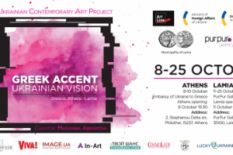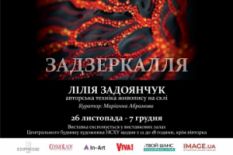Geldhof has curated numerous projects internationally, including Ukrainian National Pavilion at the 56th International Art Exhibition – La Biennale di Venezia (2015). He has curated many thematic exhibitions, such as China China, Fear and Hope, Loss: in Memory of Babyn Yar, Democracy Anew and Fragile State, and has worked with among others: Damián Ortega, Olafur Eliasson, Anish Kapoor, Tony Oursler, Jake & Dinos Chapman, Marina Abramovic, Santiago Sierra, and Carlos Motta. For the last ten years he is deeply involved in Ukranian art.
What is the mission of contemporary art in Ukrainian context, how does it interact with society?
It is very difficult to speak of mission of Ukrainian art as such. I think art has unified mission either in Ukraine or in a world. But you can see tendencies of how art is being used and in that respect, I think, a lot of the art in Ukraine, and that is of course not all, has a very clear social and political engagement. That means it deals with the society and the challenges the society finds, it deals with the topics that are difficult for developing society in country with a war and in country where you have quite fast changing political environment. And a lot of Ukrainian artists respond to that because they respond to the place where they rooted in. I would call it relations the artists build with the world around them rather than a mission.
But speaking about the PinchukArtCentre as the institution, we do have a role we should fulfil within society. I think our mission has different levels. First and foremost that is to enable critical thinking and to get people involved with art, because we do believe that art can change the way that people think. Thus, empowering people is our responsibility. The second role the PinchukArtCentre has is to create an awareness of Ukrainian art, not only abroad but also in Ukraine. That is why we launched Research Platform as a pioneering project aimed to bring the history of Ukrainian contemporary art together that has not been done yet anywhere. And we are constantly sharing our research with the public in terms of publications, exhibitions and discourses. And the third role is to make sure that Ukrainian art keeps developing. That is why we have the Future Generation Art Prize and the PinchukArtCentre Prize, awards for young contemporary artists. We invest a lot in emerging artists not only by making new productions or exhibitions but also by making sure that those young Ukrainian artists connect to the international art community.
– How have the social transformations influenced the activities and tasks of the PinchukArtCentre in recent years?
We always were an instrument to serve society. But after the Revolution of Dignity society certainly changed. Civil society emerged and it was stable and Ukrainians started to be able to travel visa free to Europe. These two critical issues influenced also how we have to think. First, we changed our exhibition practice to be not any longer focused on bringing exclusively really big names to the forefront but to engage people in content of the exhibitions, which were both politically and socially relevant, so that they could form opinion and discuss topics that were difficult to discuss. For example, we have started with Fear and Hope at the time when conversation was very difficult in the country. Inspired by the dramatic events that have changed Ukraine forever, the exhibition was very well received by society as a tool to engage with the problematics that were difficult to verbalize because they were deeply political.
The other thing we have understood is that in this new Ukraine the relation to heritage is changing dramatically. And for that reason creating a living archive of what Ukrainian art has been about before the Revolution of Dignity with Research Platform was very essential. Because when a country goes through such a dramatic event narratives are changed very easily. We wanted to guard the heritage of Ukrainian contemporary art for future generations, but also to make sure that through this pioneering project we could help Ukrainian society to build its identity. We started making exhibitions that were driven from our Research Platform and that for the first time gave young Ukrainians, which are the majority of our public, really an analytical and sometimes provocative view on their history and on the history of Ukrainian art.
– The contemporary art is often ambiguous and do not convey a clear visual message. Is the Ukrainian audience ready to understand such works?
You know, I think the responsibility of art is not to give you an answer on a question you have. Artists are not politicians that offer remedies. An artist is a person who is creating thought, creating emotion and creating critical effect. What does it mean? Art has to be ambiguous because otherwise it is a manifest. Although there are manifests that are being made by the artists well, but I think a lot of the art allows you to look at a problem that you carry within yourself from a different angle and it pushes you to think differently. Moreover, it allows for a conversation to change – and that is the most important because art is about conversation.
The PinchukArtCentre is really a place to discussion. We are never talking to you. We are always talking with you. We have very strong public program team who is everyday thinking about how to engage our audiences in a dynamic dialogue. I believe it really makes The PinchukArtCentre a unique place because you can come here and instead of getting someone who will give you a lecture about a work you will have one of our young great mediators to ask you questions, to listen to your opinion and to engage with that. After all, I do believe that the best way to get people systematically involved in art and to have the maximal impact of art is to be open. And being open means that we as an institution and our representatives in institution chair and in first place our mediators are there also to listen and to hear your story that relates to that work and to reflect on that together with you. Because in this way art really can be meaningful for you as an individual.
– What is your opinion on contemporary Ukrainian art? Could you outline the key trends of its development?
First of all, it is very exciting. I think, it is one of the places in a world where everybody should come and discover, absolutely. Talking about the role that Ukrainian artists play today in a world, I think they are gaining, they are taking more and more territory, because people worldwide are discovering Ukrainian art. But I think more attention is needed. It is not only a question about how we position ourselves globally because it has to be well structured locally also. An ecosystem has to be built.
– What would you recommend to Ukrainian emerging artists to succeed?
To be really good, I think first of all trust yourself is needed. If you trust yourself it eases you to listen to others. Because you don’t have to follow what others say – you can listen and take things you find useful and you will use them in a way that benefits your work. Secondly, if you trust yourself and you know why you are doing something – do it, don’t wait for somebody, don’t wait for money, don’t give an excuse why it is not possible. And then everything else will flow if it’s really good.

– How in a few words could you describe the national identity of Ukraine? What do you think about Ukrainians?
I would not want to say what Ukrainian identity is, I can only say how I look at Ukrainians. And perhaps that will resonate somehow with what you might call identity. Because first of all I think identity is always moving element, it is not static. Static identity is backwards.
How I think about Ukrainians? Well, first of all I think they always go for a hope. I heard a lot of people saying, “Oh, we are always so critical” or “We are always not happy with the things”. But somehow Ukrainians are always hopeful. Ukrainians are also incredibly open which I think is very related to what I said about identity. They are open to listen, they are open to discuss, they love to get into the discussion where other opinions are present. They very strongly defend their own position but at the same time they are open to change. I think the third thing is that Ukrainians are very proud. Ukrainians are proud of their nation, of what they have realised, and they carry that pride very strongly with them. If you bring these three things together and you have them in a balance you are actually very beautiful people who are both open and proud about what you have accomplished and always looking to how things can be better and hopefully in that sense. So that’s how I personally experience Ukraine and how I think about Ukrainians.

– What are your favourite destinations to travel around Ukraine?
It depends for what I am traveling. I mean, I love Kharkiv. I think Kharkiv is a beautiful city, it’s very strong it has this kind of roughness that somehow I find personally attractive and it has great art history till today. So that is for sure one of the places where I always want to go back. I also love Lviv. Lviv is much closer to Europe and it is also a place I really-really enjoy to go. But recently I’ve discovered Chernivtsi and this beautiful University that is built there. When I travel personally then I go to the Carpathian Mountains because they are so beautiful. Even just in Kyiv you can spend a fantastic week-end – you don’t always have to go out and discover some new places. I thing one of the beautiful things about living in Ukraine is that it’s never boring. You can just take your car and you will find something, which is really cool and inspiring. In another country you might ask: “What are we going to do this week-end?”, but I think in Ukraine it’s just: “Which of the different options are we going to choose?”. Because there is always something. Everywhere I travelled, there is always something that makes you wow, that is really worth coming for.







